
9 minute read
Repair of deep water pipelines by new remote welding technology
from IGU Magazine October 2016
by IGU
By Jan Olav Berge
v An illustration of the
remote welding system in operation.
In 2015 for the first time welding robots could repair subsea pipelines down to 1,300 metres water depth.
Statoil and Gassco have, after years of technology development, proven that a new remote-controlled pipeline repair system could repair subsea pipelines by using a welding robot. A qualification programme was completed with a deep water test proving that all the new equipment works down to 1,300 metres. This link contains a video animation showing the pipeline repair operation: www.statoil.com/no/ TechnologyInnovation/Features/Pages/ RemoteControlledWelding.aspx
Emergency repair of subsea pipelines is essential for all major pipeline operators, and after several years of technology development, Statoil and Gassco completed the development and qualification process of a new pipeline repair technology using a welding robot as the primary method for repair of subsea pipelines larger than 30” and in water depths currently verified down to 1,300 metres.
The new remote welding system comprises three main modules that perform the subsea pipeline joining process: ◆ Remote welding habitat ◆ Remote welding power and control (POCO), and ◆ Remote welding tool
The remote welding habitat provides a dry, gas-filled habitat for the welding operation. A claw system supports and secures the pipes in order to achieve good alignment and no relative movements between the pipe ends during the first phase of the welding operation. The remote welding habitat contains a pipe sealing door at each
end providing a gas-tight sealing system around the pipe entrance into the habitat, and a sliding side door which closes and opens for the entrance of the remote welding tool from the POCO.
The remote welding POCO is a separate module that has two primary functions in the system: ◆
It contains all power and control function to support the welding operations.
It provides dry storage of the remote welding tool during launch and recovery through the water column.
This module contains the most critical and vulnerable systems, and the option to recover this module separately from the larger remote welding habitat and the pipe preparation and positioning gives increased flexibility and improves the overall efficiency of deep-water operations. The remote welding POCO is permanently connected to the surface via an umbilical and is gas-filled with 0.4 bar overpressure relative to ambient pressure.
The last module is the remote welding tool which is a specially designed tool containing all the essential functions for the welding operation: ◆
Welding head with metal inert gas (MIG) welding torch and tip changer
Welding wire consumable
Induction heating system for sleeve and pipe joint drying and heating
Survey head for close visual inspection, and
Service head for light grinding and rework
The three modules forming the remote welding system are parts in the total remote welding spread which in addition includes tools for all preparatory work: ◆ ◆
Coating removal unit (CRU)
Weld seam removal tool
vz The power and control module for the habitat contains the most critical systems for the operation.
v The remote welding tool performs all the functions
for welding the pipeline including inspection of the completed weld.

x The remote welding
habitat provides a dry, gas filled habitat for the welding operation.

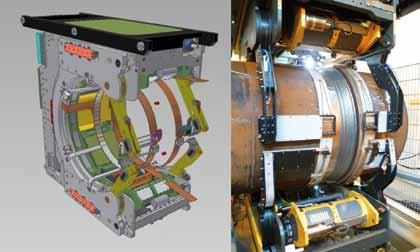
TBG is a Brazilian privately held business corporation, being a partnership among renowned worldwide energy groups. The company has been the owner and operator of the BoliviaBrazil Gas Pipeline since 1999.
The promising natural gas market in Brazil is passing through challenging times as a result of both regulatory and energy balance changes. In this scenario, TBG plays a central role to enable an efficient gas transmission system for the country.
The company delivers up to 30.08 million m³ of natural gas per day to local distribution companies, thermoelectric power plants and refineries through 2,593 kilometres of Brazilian territory. The pipeline begins in
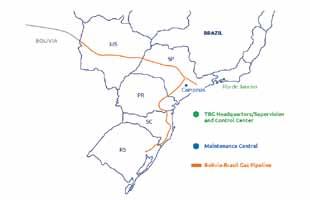
Corumbá (Mato Grosso do Sul) and ends in Canoas (Rio Grande do Sul). It also crosses the states of São Paulo, Paraná and Santa Catarina.
TBG’s installed infrastructure capacity is composed of 15 compressor stations, 50 city gates and others pipeline facilities. The whole system is
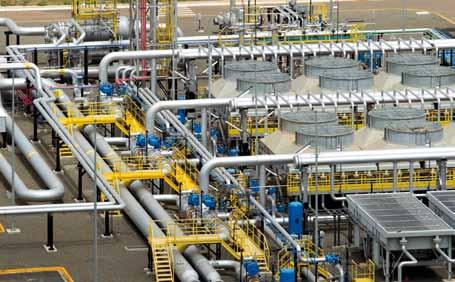

zc The compressor station in Paulinia, São Paulo is one of 15 under TBG’s control. c The Bolivia-Brazil Gas Pipeline runs through fives states in Brazil, remotely operated from Rio de Janeiro.
remotely operated on a continuous basis by TBG’s Supervision and Control Center located in Rio de Janeiro. The maintenance of the pipeline and its facilities is entirely performed by its own staff.
For 17 years, TBG has been consolidating its position, due to the recognition of its service quality in natural gas transmission and to the performance achieved by efficient management, reflected in a compression system reliability of over 98% in the last three years. The standards of excellence also come from investments in research and development of new technologies, in order to meet market demands.
As a result of recent regulatory changes, access to the Brazilian transmission system has become more open and competitive. General terms of access and an electronic platform will be available at TBG’s website (www.tbg.com.br) by the end of 2016. Until then, TBG is ready to interact with gas players, as well as helping them to build business solutions in order to meet their projects’ demands.
TBG commits to serve its clients with integrity, competence and innovation, also respecting the community and the environment, while contributing to national energy security.
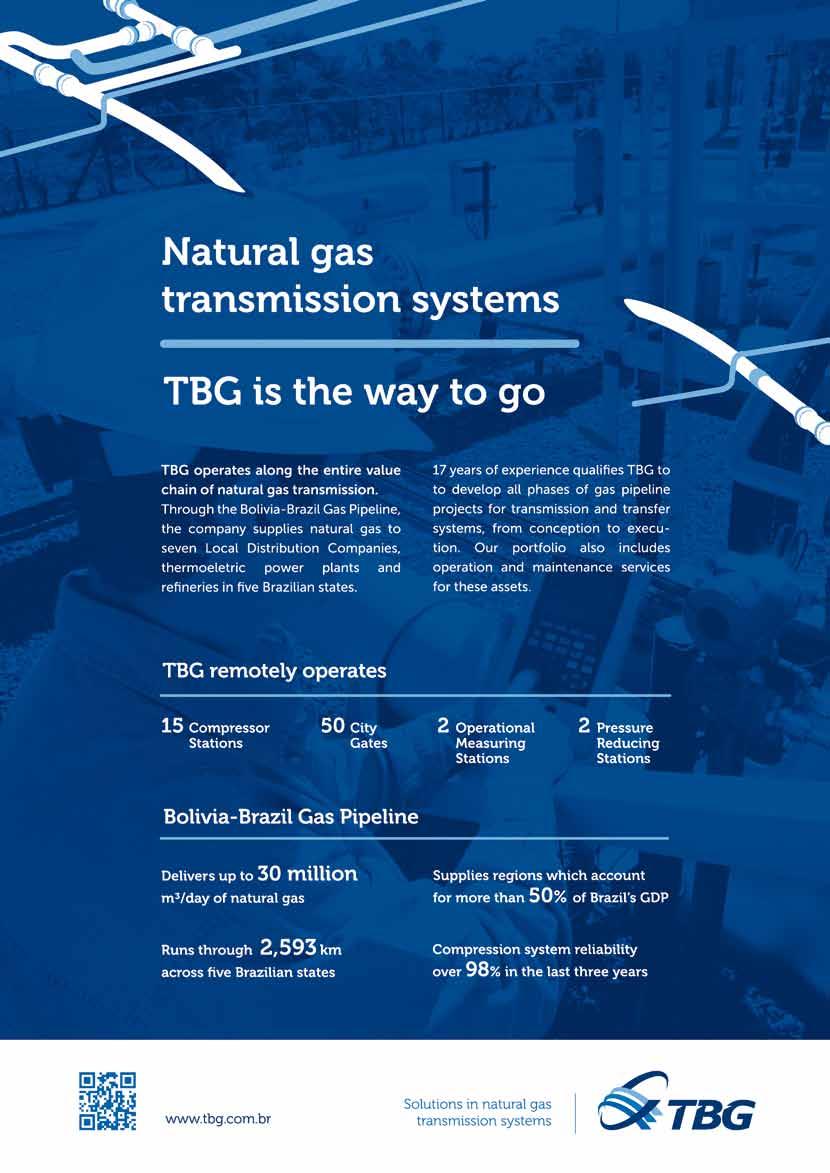
z An illustration of the
remote welding system in position on the seabed.
x Deploying the remote
welding habitat for deep water testing.

Hydraulic lifting frames (3 to 4 ‘H’-frames needed in the operation)
Pipe cutting tool
Welding pigs and insertion tool, and
Pipe alignment and monitoring system
The above tools are all operational in the Norwegian Pipeline Repair and Subsea Intervention (PRSI) Pool and are commonly used for subsea pipeline tie-ins and repairs.

The operational steps using the remote welding system are first to install the remote welding habitat by means of the vessel crane. At this stage the pipe ends are prepared by removing all external coating, cutting to length and welding pigs are installed in each pipe end to create the barrier towards the gas pocket in the habitat. After landing the habitat on the
seabed, the pipe ends are lifted into the habitat and secured by the pipe claws, the pipe doors and side door are closed. Then the habitat closure is filled with argon gas (blowdown) and the inert atmosphere dehumidified in order to establish acceptable environmental conditions for the welding process.
The second stage of the operation is to launch the POCO over the vessel side or by means of a module-handling tower through the vessel moon-pool. The enclosure is kept at a constant gas overpressure of 0.4 bar in order to ensure no water leakage into the electrical systems, welding tool and consumables. The POCO is landed on the habitat side platform and engaged on the connection interface. After verifying the interface seals are tight, the connection system is dewatered and opened to allow the remote welding tool to enter the habitat, the tool is driven to the pipe and the pre-heat bands are closed and engaged around the pipe.
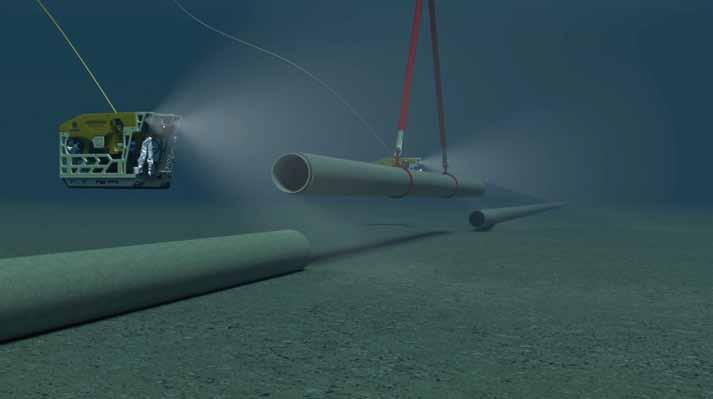

The pre-heat system then heats the pipe to a specified temperature and the welding path is learnt and logged by the welding tool. Welding may then commence and the preprogrammed welding sequence is performed under supervision and control by a welding operator and a welding engineer.
Acceptance of weld quality is based on a process monitoring quality control system using predetermined ranges for all essential welding parameters. All parameters within a ‘green zone’ means an accepted weld, while deviations need to be assessed and in a worst
zz The repair spool and
welded sleeve design. Traditional butt welding techniques are challenging in an automated system so sleeve welding was chosen as an appropriate solution.
case the rejected portion of the weld pass has to be ground away by the onboard service head grinding tool.
An important part of the development of the remote welding system was to develop a suitable pipeline repair strategy and method of joining the pipe ends together. Traditionally pipeline welding is performed by a butt weld joining technique, i.e. welding the abutting pipe ends by a full through-wall thickness weld. In an automated system this technique presents several challenges, and this was the main reason for choosing a sleeve welding repair technique that is less demanding at this phase of development.
The oversized thick wall sleeve is prewelded to each end of the repair spool during onshore fabrication, while the final weld between the sleeve and pipeline is made subsea inside the dry habitat. The weld is designed to the actual strength requirement, and is grossly over-dimensioned in order to distribute the stress concentration into the highly utilised pipe wall outside the weld sector.
The equipment that has been developed is another step in a continuing drive for increased capacity, application range and water depths for subsea pipeline repair technology. Since 1987 the PRSI Pool in Norway has continuously developed new technology and capacity to cover the members’ need for pipeline repair preparedness. Today, 13 operating companies are part of this pool, and more than 15,000km of pipeline are covered by the pool services.
Further development of the remote welding system is typically foreseen within the following areas: ◆
Extend the diameter range to smaller size pipelines
Develop in-situ shallow water repair down to a water depth of 9 metres ◆ Extend the water depth capacity to 2,500-3,500 metres ◆ Develop a methodology for repair of clad or lined pipelines
Expanding the remote welding system to smaller size pipelines will most likely be done in two steps; the current system can be modified to accommodate down to 24” pipelines relatively easy by simple geometrical modifications, but in order to expand the diameter range to cover pipelines from 10” to 24”, a slight adjustment in concept is required to utilise the size benefits.
Increasing capacity for deeper water depths down to 2,500-3,500 metres, based on experience to date, is best solved by a new concept for gas and performance optimisation and a development project is foreseen to realise such possibilities.
Another application area where remote controlled technology may be beneficial is in the very shallow water range, typically from 9-20 metres. This is a depth range where diver-assisted operations are very demanding and resource intensive. Studies to look into how the new remote welding system could be utilised for this depth range is ongoing and could well result in further developments and new application opportunities.
Finally, the new remote welding system may be applied on bi-metallic materials such as for the repair of clad or lined pipelines. This capacity requires further development of the welding technique while the basis technology and system are the same.
A hyperbaric welded repair is superior to any mechanical repair due to its lifetime, reliability and pipeline integrity. This is the main business driver to continue development of this technology for new applications in the future.
Jan Olav Berge is Senior Advisor Pipeline Technology, Statoil.










